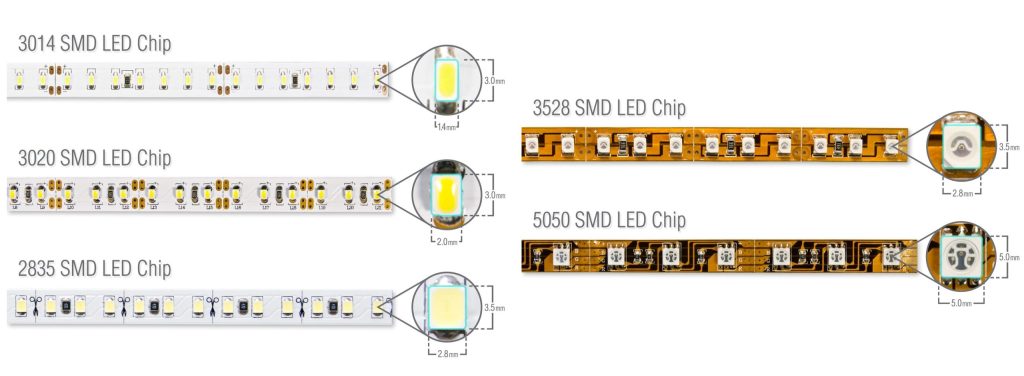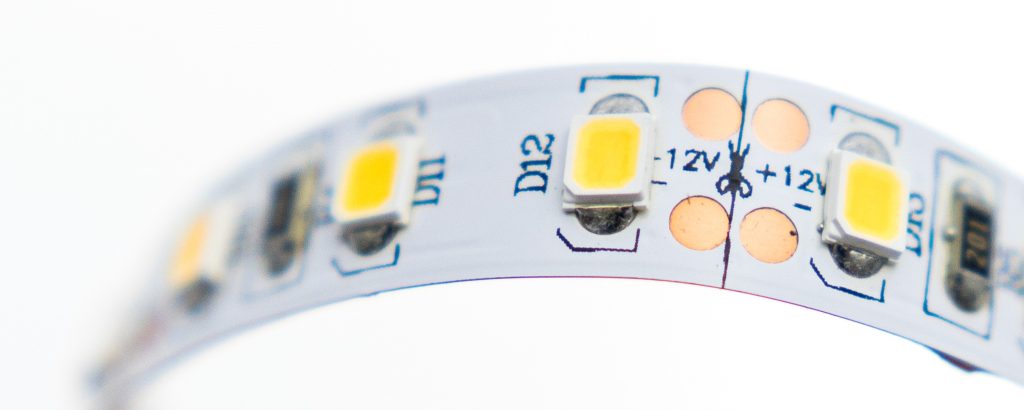A Deeper Look into What Strip Lights Really Are
The Luminous World of Strip Lighting
As we traverse through the evolving landscape of modern lifestyle and technology, our surroundings are in a constant state of transformation. One such transformative element is the revolution in the lighting domain, and at the heart of this revolution lies strip lighting. It brings forth a fusion of aesthetics and functionality that enhances or changes the mood of any space, be it your home or workspace.
The arrival and adaptation of LED technologies have allowed us to experiment with lighting like never before, giving birth to concepts like smart LED strip lights, RGB LED strip lights, RGBIC LED strip lights, Wi-Fi LED strip lights, and landscape strip lights, among others. But what exactly are these intriguing elements known as ‘strip lights’? Let’s delve deeper into their definition to understand them better.
Shedding Light on Strip Lights: Definition
In essence, a strip light is a row of electric lights, often LEDs, mounted on a narrow and flexible circuitboard that can be hung or stuck to a surface. These innovative pieces are also known as LED tape or ribbon light due to their resemblance.
Their versatility allows them to be used for accent lighting in hidden locations like under cabinets or behind televisions for ambient effect; however, their usage isn’t confined to indoors only. They also serve an important role in landscape lighting, bringing life to gardens and outdoor spaces in mesmerizing ways during nighttime.
The interesting aspect about these strips is their ability to deliver diverse hues depending upon the type you choose. For instance, red-green-blue (RGB) LED strip lights can create dynamic color mixing effects, while red-green-blue-individual-control (RGBIC) allows individual control over each emitted color, leading to more vibrant display patterns.
Lights Through the Ages: Brief History and Evolution of Strip Lights
The history of strip lights is a fascinating journey that takes us back to the early 20th century. Originally, they were found in theater productions as border lights, named for their placement around the stage borders. Gradually, they gained popularity and became a common aspect of commercial lighting design. The real game-changer arrived with the advent of light-emitting diode (LED) technology in 1962.
Unlike their predecessors, LEDs offered several advantages, such as longer life expectancy, lower energy consumption, smaller size, and faster switching. Further advancements allowed for the creation of flexible LED strips – a more versatile solution that could be adapted into countless applications, from accent lighting in homes to landscape lighting and beyond.
The revolution didn’t stop here as we witnessed technological breakthroughs like WiFi LED strip lights that can be controlled via smartphones or smart home systems, providing users with unprecedented control over their lighting. As we continue our journey through time, we are bound to see further innovations in strip lighting reshaping our perceptions about how light impacts our surroundings and enriches our everyday experiences.
Types of Strip Lights
An Exposition into the Diverse Spectrum of Strip Lights
Strip lighting has evolved to embody a myriad of types and functionalities. The most prevalent among these are LED strip lights, fluorescent strip lights, and RGB strip lights. Each kind brings its own unique features and benefits to the landscape of lighting technology.
LED Strip Lights
The Emergent Luminary: Overview and Uses
LED strip lights, also known as tape lights or ribbon lights, are flexible circuit boards populated by surface-mounted light-emitting diodes (SMD LEDs) and other components, usually with an adhesive backing. Traditionally, they were used in accent lighting, backlighting, task lighting, and decorative lighting applications. Nowadays, their application scope has expanded significantly, making them a popular choice for both residential and commercial purposes.

These innovative strips can be a great component in landscape lighting design as they help create dramatic effects while being energy efficient. They have been smartly engineered into what are known as smart LED strip lights, which incorporate features such as WiFi connectivity, enabling users to control them remotely from smartphone apps.
Reaping Lumens: Advantages and Disadvantages
The advantages of LED strip lights are manifold; they consume less power, hence saving on electricity bills. They have a long lifespan – typically 25,000 to 50,000 hours – which reduces replacement costs too. Furthermore, these strips offer flexibility owing to their ability to be cut at specific intervals.
However, like all things bright and beautiful, it’s not without its downsides – while installing LED strips may seem straightforward, there can often be hidden complications with connections or incompatible power supplies, which require technical experience.
Fluorescent Strip Lights
Radiating Persistence: Overview & Uses
Fluorescent strip lights have been a staple in commercial and industrial lighting for several decades. They are elongated fixtures that contain one or more fluorescent tubes. These have been widely used in spaces like workshops, garages, and large retail areas due to their bright yet diffused light output. The enduring appeal of fluorescent strip lights can be attributed not just to historical precedence but also to their reliable performance, making them an important part of the landscape lighting industry even today.
A Tale of Glowing Tubes: Advantages & Disadvantages
Fluorescent strip lights are known for their efficiency – they use less energy than incandescent bulbs and provide a significantly longer lifespan. Moreover, they generate less heat, which makes them safer for long-running applications. However, the disadvantages include inconsistency in color rendering and sensitivity to temperature changes. Also, frequent switching on & off can drastically reduce its lifespan.
RGB Strip Lights
The Kaleidoscopic Radiance: Overview & Uses
RGB strip lights stand for red, green, and blue – the primary colors in the color spectrum. When controlled digitally, these strips can emit any color by blending different intensities of red, green, and blue, hence giving it its name RGB LED strip lights.
The added dynamism offered by these strip lights has opened avenues for creative applications both indoors and outdoors. With the advent of technically advanced versions like WiFi RGB LED strip lights that can be controlled via smartphone apps or voice commands using home automation systems, it’s now easier than ever to control your ambient lighting at home or even in professional setups.
Painting with Light: Advantages and Disadvantages
The chief advantage of RGB LED strips is their ability to produce a wide variety of colors, including white light – this makes them highly versatile decorative fixtures. In addition, many such strips come with programmable settings allowing for dynamic color changes, fades, and pattern shifts.
However, RGB LED strips are typically more expensive than single-color LED strips and require a more complex installation process. Moreover, they require advanced controllers to manage the different colors and effects.
Key Components of a Strip Light System: The Core of Lighting
Unraveling the anatomy of a strip light system, we encounter four pivotal components. First and foremost, lighting in these versatile fixtures is provided by light-emitting diodes (LEDs). These miniature semiconductors emit photons, creating the visible light we perceive.
LEDs have become popular due to their efficacy, durability, and long lifespan. They come in various forms, including RGB LED strip lights, which offer multicolored lighting.
Secondly, these LEDs are mounted on a flexible circuit board (FCB). This pliable foundation permits the strip lights to be arranged in diverse shapes and patterns suiting specific aesthetic or functional requirements. It also serves as an electrical highway connecting all LEDs and facilitating their collective operation.

The third component is the adhesive backing that aids in attaching the strip light onto various surfaces. It’s designed for easy application while ensuring a firm grip once installed. However, it may necessitate additional fixing measures like clamps or screws on non-smooth or vertical surfaces.
The final link in this chain is the power supply units (PSU), responsible for converting mainline voltage into a suitable level for the LED operation. PSUs often include controls such as dimmers or color changers, thereby adding further functionality to your lighting system.
Safety Measures during Installation & Use: Precaution for Perfection
The first rule of electrical safety is to ensure that the power supply is switched off before starting your installation process. This simple measure can help avoid any accidental shocks. Consequently, it’s also advisable to refrain from touching the LEDs immediately after use, as they may heat up over time.
In terms of maintenance, regularly clean your LED strips with a soft, dry cloth. Avoid using water or other liquids, which may damage the circuitry. Keep them away from sharp objects that could puncture through and damage internal wiring. Compliance with these measures will prolong your strip lights’ lifespan and efficiency.
Installation Process for Different Types of Surfaces: A Handy Guide
Installation on Wood Surface
When installing strip lights on wooden surfaces, certain tools become indispensable; namely, a measuring tape for precise positioning, a clean cloth for surface preparation, and potentially a screwdriver if extra-strength adhesive methods are employed.
The installation process starts with planning out your desired layout, followed by cleaning the area with a cloth to ensure optimal adhesion. Next, the protective layer covering the adhesive backing is removed, and the strip light is gently pressed onto the surface. Finally, connect to a power supply and bask in your new ambient glow.
Installation on Glass Surface
For glass surfaces, the toolkit remains largely similar, but utmost care must be given to cleaning. The surface must be devoid of dust or moisture to prevent slippage or adhesive failure. Align carefully and press firmly once satisfied with placement. A noteworthy point while installing strip lights on either surface is safety. Missteps could turn this simple endeavor into an electric hazard. Therefore, prioritize safety above all else.
Common Problems with Strip Lights & Troubleshooting Tips: Navigating Bumps in Brightness
Despite their robust functionality, strip lights are not without problems. One common issue faced by users includes flickering or non-working LEDs. Often, this can be attributed to loose connections within the system. Ensure all connections are secure; if issues persist, a faulty LED might be at fault, warranting professional assistance.
Adhesive failure ranks second amongst recurrent grievances. The adhesive used may not hold up well against certain conditions like humidity, dust, or temperature fluctuations. Examine the environment before installation and take necessary measures such as additional fasteners or using adhesive primers.
The Future of Lighting – Technological Innovations in the World of Strip Lighting: Harnessing Brilliance
As technologies advance, so do strip lights. Today, we can find smart LED strips that seamlessly integrate into our home automation systems, providing an unprecedented level of control and customization. Furthermore, strip lights are also becoming more energy-efficient with every passing year. This not only reduces ecological footprint but also results in significant savings on energy bills. All these developments point towards a brilliant future for strip lights, be they RGBIC LED strip lights or WiFi LED strip lights.
The Versatility, Beauty, and Practicality of Strip Lighting
The world of lighting has been revolutionized by the advent of strip lighting. Its myriad applications range from creating ambient mood lighting to enhancing landscape lighting. Easy to install yet highly adaptable, energy-efficient yet impressively luminous, strip lights provide an elegant solution for diverse lighting needs. As we continue to explore its potential, the future appears bright indeed!
Rarely Known Facts about Strip Lights: Unveiling Luminary Secrets
Peeking into rarely known facts about strip lights, it’s fascinating to note their early use in theater productions. They were deployed for footlighting, a technique used to spotlight performers from below. And while today’s uses are more versatile, the theatrical heritage still shines through in the dramatic ambiance they create wherever they’re installed.
You may also be interested in the following posts:
